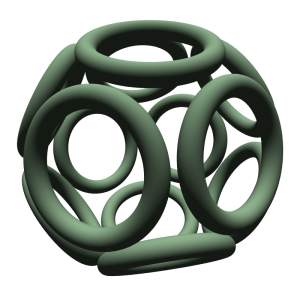|
Indrek's home
|
Crystal Space
|
SableCC
|
JIT-PHP
|
JTLT
|
libCHMxx
|
SUSHI
|
Ephi
|
Varphi
|
AVR: timer
|
AVR: speakit
|
AVR: flashme
|
AVR: IR troll
|
Octave
|
Misc
|
Geiger
|
Battery
|
Scintillation
|
libfbm
|
|
Ephi - the simple physics simulator
Notice: Ephi is something I wrote many years ago, before I seriously got into physics. It's low quality and very amateurish. I really didn't know what I was doing half the time, but it sure was fun. So ephi is not "serious" software. If you're looking for a serious solution, look elsewhere. Ephi is a C++ physics simulation software to simulate static magnetic fields and movement of charged particles in those fields (using the Lorentz force). Coulomb forces are also accounted when simulating particle paths. So Ephi allows you to model and visualize magnetic fields through current elements and also to visualize electron paths within those fields. Magnetic fields are calculated using numeric integration over the Biot-Savart law. For example on these images you can see the magnetic field strength and field lines from the cross section of a solenoid. Field line images are calculated using the line integral convolution. The images on the right use logarithmic field levels for coloring.
Simulation of moving electrons within the magnetic field is also supported. For example here you can see an electron trapped around a circular current element: Field lines can also be integrated (from a solenoid and a cube polywell crossection here): Electric field is also accounted for (two opposite charges; logarithmic field strength and field lines): You should read the README.txt. Ephi is currently licensed under the GNU General Public License. It should run out of the box on any Linux system. This software does not come with any graphical user interface, windowing or anything. It's a hard-core for-fun thing. Ephi is currently at version 0.14. Click here to download the source code with included windows executables: ephi-0.14.zip (Changelog.txt). You can also get the current development code from a SVN repository: I'm not a physicist nor am I a mathematician. Neither do I have any backgrounds in those fields, numeric calculation or simulation software. So in other words I'm a complete amateur and this software is intended to be used by other amateurs like me who don't take life too seriously. Animations of the fields can also be constructed by applying a Hanning ripple function to the line integral convolution. This helps to see where and how the field lines go. Ephi is currently being developed by Indrek Mandre. The release announcements, discussions about ephi, fusion, polywell etc. happen in the IEC Fusion Group. Come and join us. Polywell simulation

The primary goal to create Ephi was to simulate the polywell inertial electrostatic confinement nuclear fusion device and see how electrons are contained within it. It is claimed that this device can keep electrons within using magnetic mirrors and so create a deep potential well (with negative charge). By letting deuterium ions (with positive charge) fall into the negative well they will collide in the middle with enough speed to fuse, releasing fusion energy. Here you can see a dodecahedron configuration with 12 circular magnets all facing inwards. 
As there are lots of circular current elements ephi will slow down. This simulation was done with 100,000 ampers of current and ~0.3m radius magnets set into a dodecahedral configuration. A single electron was let loose in the middle of the system with speed of 500eV (electronvolts). The simulation produces a path log of the electron and images of the electron's path within the system. The images are projected against the axes of the coordinate system (coordinate planes), the magnets are drawn as well to the background. Two images per projection are provided, one overview and another for a closer look into the middle. As you can see the electron zigzags around for a while (around 11 meters) and then finds a way out. NOTE: the coils are not charged in this simulation, so this is a simple magnetic bottle simulation. The XY projection: B-field strength and lines across the XY plane for the cube configuration (logarithmic field levels on the right): E-field strength and lines across the XY plane for the cube configuration (logarithmic field levels on the right): B-field and E-field of cube polywell taken through the corners (logarithmically colored to field intensity): B-field strength across the XY plane for the dodecahedron configuration (logarithmic field levels on the right): Videos of electron paths inside the cube polywell:
The application also provides povray 3D raytracing scripts. For example polywell_dodec.pov.
Wallpapers
Some pretty and interesting graphics for desktop wallpaper buffs. |
|